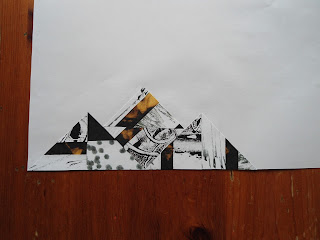The following set of fabrics were machine stitched using cable and whip stitch in a hopefully sympathetic manner complimenting the previously painted and bleached fabrics.
(i) Cable stitched a previously 'failed' shibori dyed, then monoprinted, fabric. Black pearl cotton #8 in bobbin and white sewing thread in top. Bobbin case had all tension removed; no tension alteration on top. Zig zag stitch with feed dogs up; alternated width as I sewed; also moved fabric while sewing to create curved lines.
(ii) White fabric monoprinted with black fabric paint using bubble wrap. Stitched using zig zag up and down fabric, curving around circles, while adjusting width and length of stitch; feed dogs up. On the slightly lighter section of the fabric I zigzagged around the barely visible circles. Might repeat this in a larger piece of fabric but using lowered feed dogs and a darning foot for free machining zig zag. This was fun to do, reminded me of vermicelli stitching in quilting.
(iii) Cable stitched white PC#8 on black bleached commercial fabric; black sewing thread on top; feed dogs up. No tension in bobbin. 3 step zig zag stitch, altering length and width. Then added layers of overstitching using white sewing thread and same machine stitch. Really like the toned effect created by the lighter layers of stitching with sewing thread. Will likely repeat this and use in final project.
(iv) Black on black: Fabric dyed, more charcoal than black, (it looks blue in the photograph but is actually a rather dark charcoal!)cable stitched using black PC#8 in bobbin and black sewing thread on top; feed dogs up. 3 step zig-zag (#4 on machine). Altered length mostly and moved fabric while stitching to create curves.
(v) Black whip stitch on white fabric: Using the same bobbin as used for cable stitch, ie the tension removed entirely, I placed a bobbin of ordinary black sewing thread in the case and used white sewing thread on top, tightening the upper tension to its tightest (10), I machined zig zag quite quickly as I sewed, moving fabric to create curves and altering length and width as I went.
All in all I am quite pleased with my fabric samples and look forward to creating larger pieces for my final project. I am beginning to overcome my fear of whip stitch and cable stitch. This time there were no difficulties sewing the samples.

























